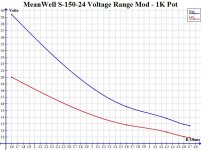DrkAngel said:
MegaMod is great as a fixed multi-use charger ...
But my typical use sets it on the cool floor amidst wires etc. and is liable to have its dials bumped ... with "unwanted results".
So, I feel it advisable to build a version dedicated for charging specific battery packs.
Note - Optimal charged voltages determined by utilizing voltage areas of greatest energy densities
It appears that my 7s LiPo packs would be optimally charged at:
27.44V (3.92V/cell) 45% capacity - ~800% usable cycles 12Ah
28.14V (4.02V/cell) 65% capacity - ~400% usable cycles 17.35Ah
28.84V (4.12V/cell) 90% capacity - ~200% usable cycles 24Ah
Using a 3 position on/off/on switch, I can apply 3 separate resistance values at SVR1.
This will provide 3 separate charged voltages from a positive position switch.
Of course, I will install the Volt Amp meter for monitoring and confirmation.
Same switch method could also be applied to S-150-48 (or S-350-48) for various optimal charge voltages or quick change for 13s or 12s or 10s or 9s packs
Packs will be maintained at:
3.92V - for maximum life.
4.02V - for extra range during hot weather (4.10V+ reputed as very damaging in hot environs)
4.12V for maximum range during reasonable temperatures ~<90ºF
Additional charge level applied for extended cruising or trips.
Note - 4.12V optimized for hot weather if battery charged in cool area (<80ºF?) and discharged below 4.10V reasonably soon (before battery gets heated up.)




